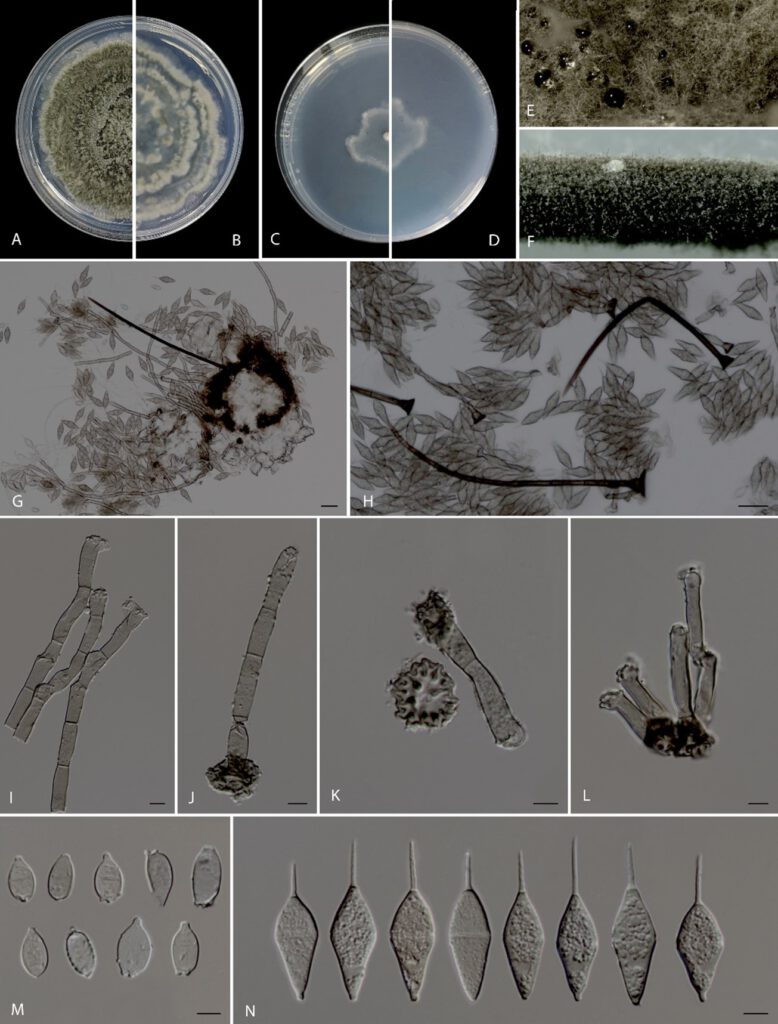Beltrania liliiferae P. Razaghi, M. Raza & L. Cai sp. nov.
Mycobank number: MB 844848; Index Fungorum number: IF 844848; Facesoffungi number: FoF 12673;
Etymology – The name refers to the host “Magnolia liliifera”.
Holotype – HMAS 352088.
Sexual morph: Setae numerous, erect, arising from radially lobed basal cells, straight to flexuous, unbranched, 2–6-septate, thick-walled, verrucose, dark brown to black, 155–207 µm long, 4.5–7 µm wide, tapering to a pointed apex. Conidiophores macronematous, mononematous, single or in small groups, erect, unbranched, hyaline to pale brown, smooth, straight to flexuous, mostly geniculate at the apical region, 2–12(–23) septate, 37–91(–380) × 4–7.5 µm, arising from basal cells of setae or from separate dark brown, swollen, radially lobed cells, 11–19 μm (av. =13.47 ± 2.32 μm) diam. Conidiogenous cells polyblastic, integrated, terminal, sympodial, with several flat-tipped denticles, cylindrical, clavate, subhyaline to pale brown, smooth, (14.5–)18–24.5 × 4.5–8.5 μm (av. =20.71 ± 4.37 × 6.11 ± 1.35 μm). Separating cells hyaline, finely roughened, aseptate, ellipsoidal, obovoid, 9.5–13 × 5–7 μm (av. =10.81 ± 0.97 × 5.68 ± 0.47 μm), with several apical, flat-tipped denticles. Conidia arise directly from conidiogenous cells or from separating cells, acrogenous, biconic, rhomboidal, aseptate, solitary, smooth, pale brown to pale smoky-brown with a hyaline to subhyaline equatorial transverse band, with distinct granules, rounded or 1-denticulate at the base, 20–25 × 8.5–10 μm (av. =22.66 ± 1.39 × 9.36 ± 0.51 μm), apical appendage 7–12 μm (av. = 8.94 ± 1.29 μm) long, tapering to an acutely rounded tip. Sexual morph: Undetermined.
Culture characteristics – Colonies on PDA raised, with undulate edge, smooth, grayish green from above, reverse centric circles in grayish green and cream, velutinous, producing olivaceous exudate droplets on aerial mycelia, reaching 71–77 mm diam after 7 d at 25 °C; on SNA flat, with undulate edge, colourless, sparse aerial mycelia, reaching 36–42 mm diam after 7 d at 25 °C.
Material examined – Unknown place, on dead leaves of Magnolia liliifera (Magnoliaceae), Unknown date, Anonymous (HMAS 352088, holotype), ex-holotype living culture CGMCC 3.23464 = LC0063.
Other specimens examined – Unknown place, dead leaves of Magnolia liliifera, Unknown date, Anonymous, living culture LC15869.
Notes – Based on phylogenetic analysis of combined LSU and ITS sequence data, two isolates of Beltrania liliiferae grouped together and formed a distinct clade closely related to Bel. rhombica. However, it differs from the latter by having longer setae (155–207 µm vs. 103–167 µm), larger conidiophores (37–91(–380) × 4–7.5 µm vs. 22.5–46 × 2–4.5 μm) and wider conidia (8.5–10 vs. 6–8.5 μm) (Lin et al. 2017). Beltrania rhombica lacks type material, therefore, to ensure better designation of the species, recollecting on Citrus limon in Italy is required.

Fig. ****** Beltrania liliiferae (HMAS 352088, holotype) a–d Upper and reverse views of cultures on PDA and SNA after 1 week of inoculation, respectively. e Exudate droplets on PDA. f Conidiophores and setae on pine needle on SNA. g–h Setae, conidiophores, conidiogenous cells and conidia. i–l Conidiophores and radial lobed basal cells of conidiophores. m Separating cells. n Conidia. Scale bars: g–h = 20 µm, i–n = 5 µm
